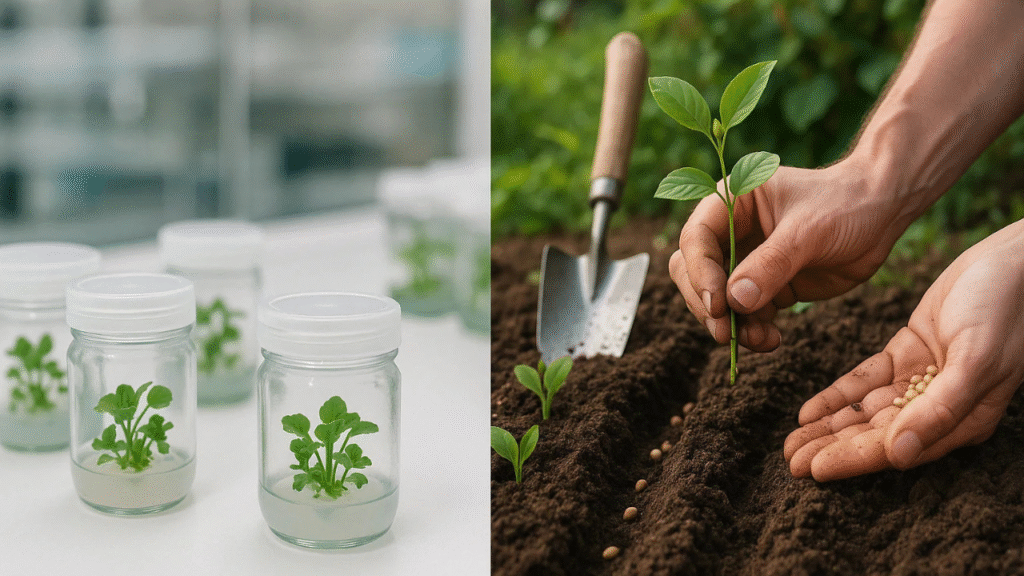
Micropropagation vs. Traditional Propagation: Key Differences and Benefits Explained
When it comes to growing and multiplying plants, gardeners and horticulturists often find themselves choosing between micropropagation vs. traditional propagation. While both methods serve the same goal of plant reproduction, they are worlds apart in technique, efficiency, and results. 🌱
Whether you’re a seasoned gardener looking to scale up your plant collection or a beginner seeking the best method for your favorite varieties, understanding these two approaches is key. 🌼 In this article, we’ll explore the key differences and benefits of each, helping you make the right choice for your plant propagation needs. 🌸
Table of Contents
Toggle🌱 What is Micropropagation? 🌿
Micropropagation is a modern technique used to grow plants from small tissue samples, like cells or plant buds, in a controlled, sterile environment. This method allows for the rapid production of large quantities of genetically identical plants. 🌿

The process starts with a tiny piece of plant tissue, typically taken from the stem or leaf. This tissue is placed in a special growth medium containing nutrients, hormones, and vitamins that promote growth. The tissue then forms new shoots, which are carefully separated and grown into full-sized plants. 🌸
Key Benefits of Micropropagation:
- Fast Plant Production: It’s much quicker than traditional propagation, producing mature plants in a fraction of the time.
- Disease-Free Plants: Since the process occurs in a sterile environment, plants grown this way are free from diseases and pests. 🦠
- Genetic Consistency: Every plant produced is genetically identical, ensuring consistency in size, shape, and characteristics. 🔄

Micropropagation is ideal for large-scale operations, rare plants, or when you need to produce large batches of disease-free plants quickly. 🌟
What is Traditional Propagation? 🌿
Traditional propagation refers to the natural methods of growing new plants, typically through seeds, cuttings, or other vegetative techniques. These methods have been used for centuries and are simple, accessible, and effective for gardeners of all experience levels. 🌻

Common Traditional Propagation Techniques:
- Seeds: The most natural form of propagation, where seeds are planted and grow into new plants. 🌱
- Cuttings: A piece of a parent plant, like a stem or leaf, is placed in soil or water to grow roots and develop into a new plant. ✂️
- Layering: A stem is buried in soil while still attached to the parent plant, encouraging root growth. 🌸
- Grafting: Different plant parts are joined together to grow as one, often used for fruit trees. 🍎
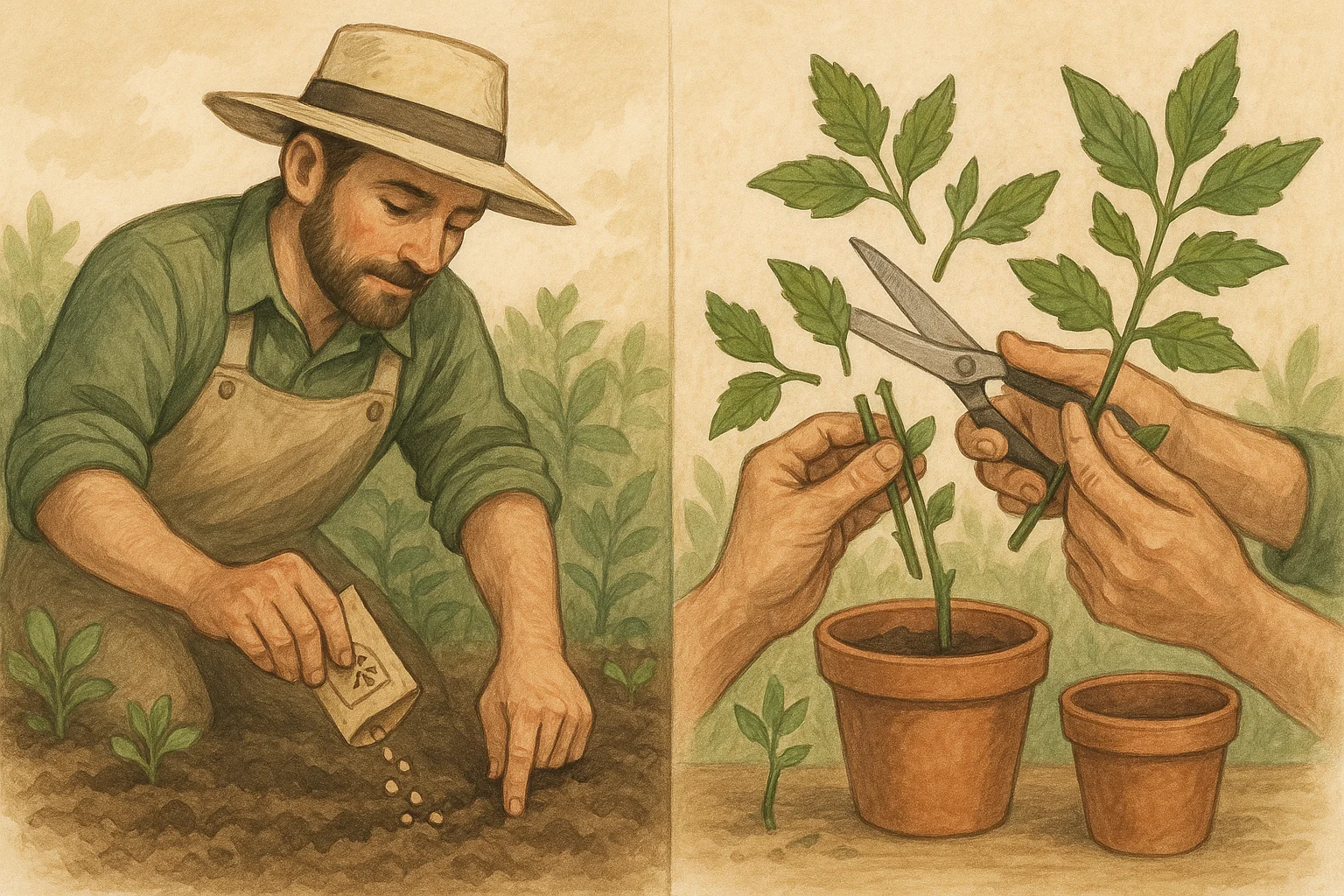
Benefits of Traditional Propagation:
- Simplicity: It’s easy to do with minimal equipment. Perfect for beginners! 🌼
- Cost-Effective: You don’t need fancy tools or techniques, making it affordable. 💰
- Natural Variation: Traditional methods can produce plants with slight differences, offering natural diversity in growth. 🌳
Traditional propagation is ideal for home gardeners, small-scale operations, and when you want a more hands-on, natural approach. 🌸
⚖️ Key Differences Between Micropropagation and Traditional Propagation 🌿
While both micropropagation vs. traditional propagation aim to grow new plants, they differ in several key areas that can impact your gardening decisions. Here’s a quick comparison: 🌱
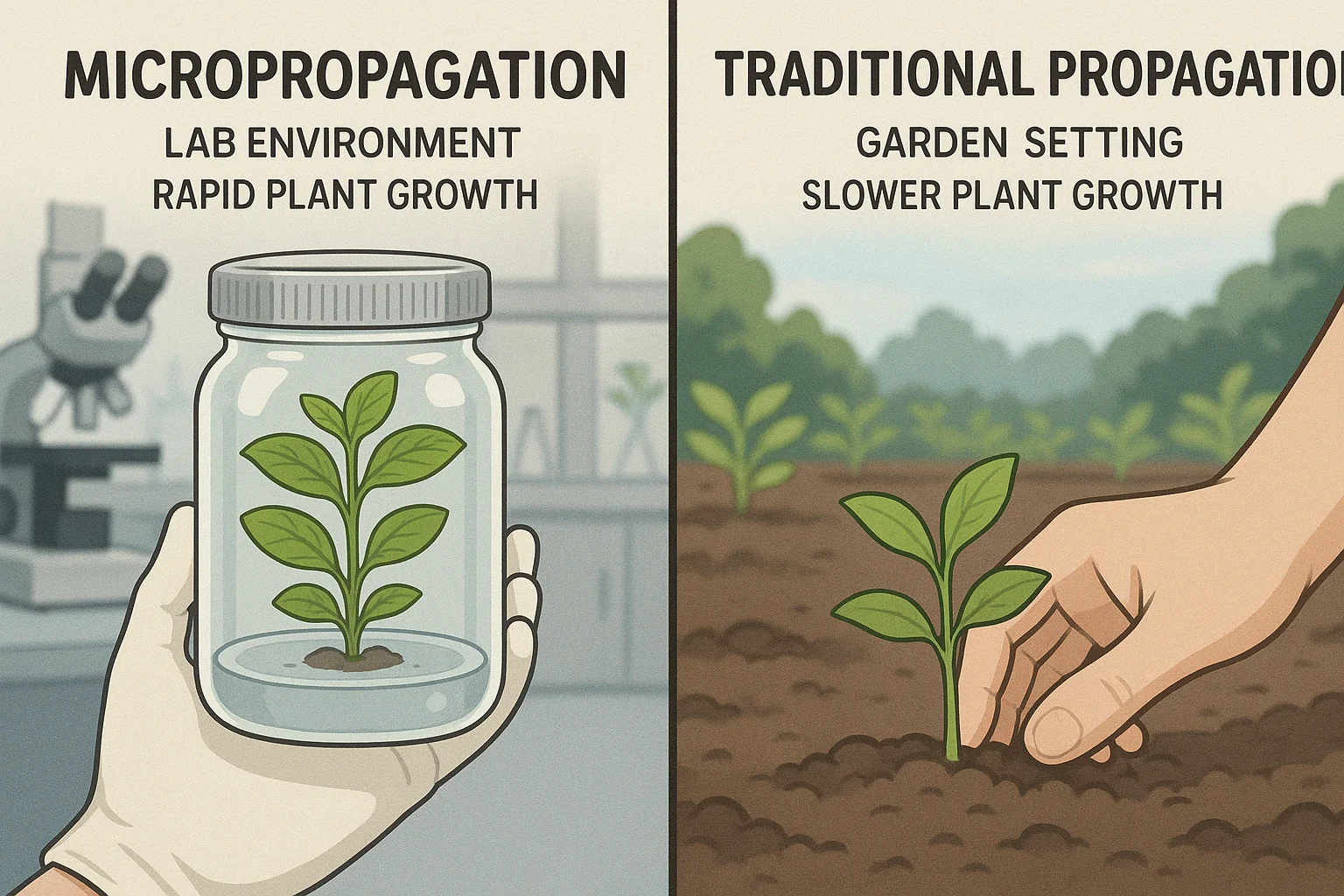
1. ⏱️ Speed of Growth
- Micropropagation: Plants grow much faster because tissue culture promotes rapid multiplication.
- Traditional Propagation: This method takes more time, as seeds or cuttings need time to root and grow. 🕰️
2. 💸 Cost
- Micropropagation: Generally more expensive due to the specialized equipment and sterile environments required.
- Traditional Propagation: More affordable and accessible since it requires minimal tools and resources. 💰
3. 🌿 Plant Health and Consistency
- Micropropagation: Ensures disease-free plants and uniformity in size and traits.
- Traditional Propagation: Results can vary, with some plants being more prone to disease or inconsistencies. 🌱
4. 📈 Scalability
- Micropropagation: Best for mass production—ideal for commercial growers or large-scale operations.
- Traditional Propagation: More suited for small-scale gardeners and hobbyists. 🌍
5. 🌱 Plant Type Suitability
- Micropropagation: Works best for rare plants, hard-to-root varieties, or crops needing quick multiplication.
- Traditional Propagation: Great for more robust plants that are easy to propagate and don’t need rapid growth. 🌳
Understanding these differences helps you choose the right method based on your plant goals, resources, and needs. 🌟
🌱 When to Choose Micropropagation 🌿
Micropropagation is a powerful tool for specific situations where traditional methods might not be as effective. Here are the ideal times to choose micropropagation: 🌸
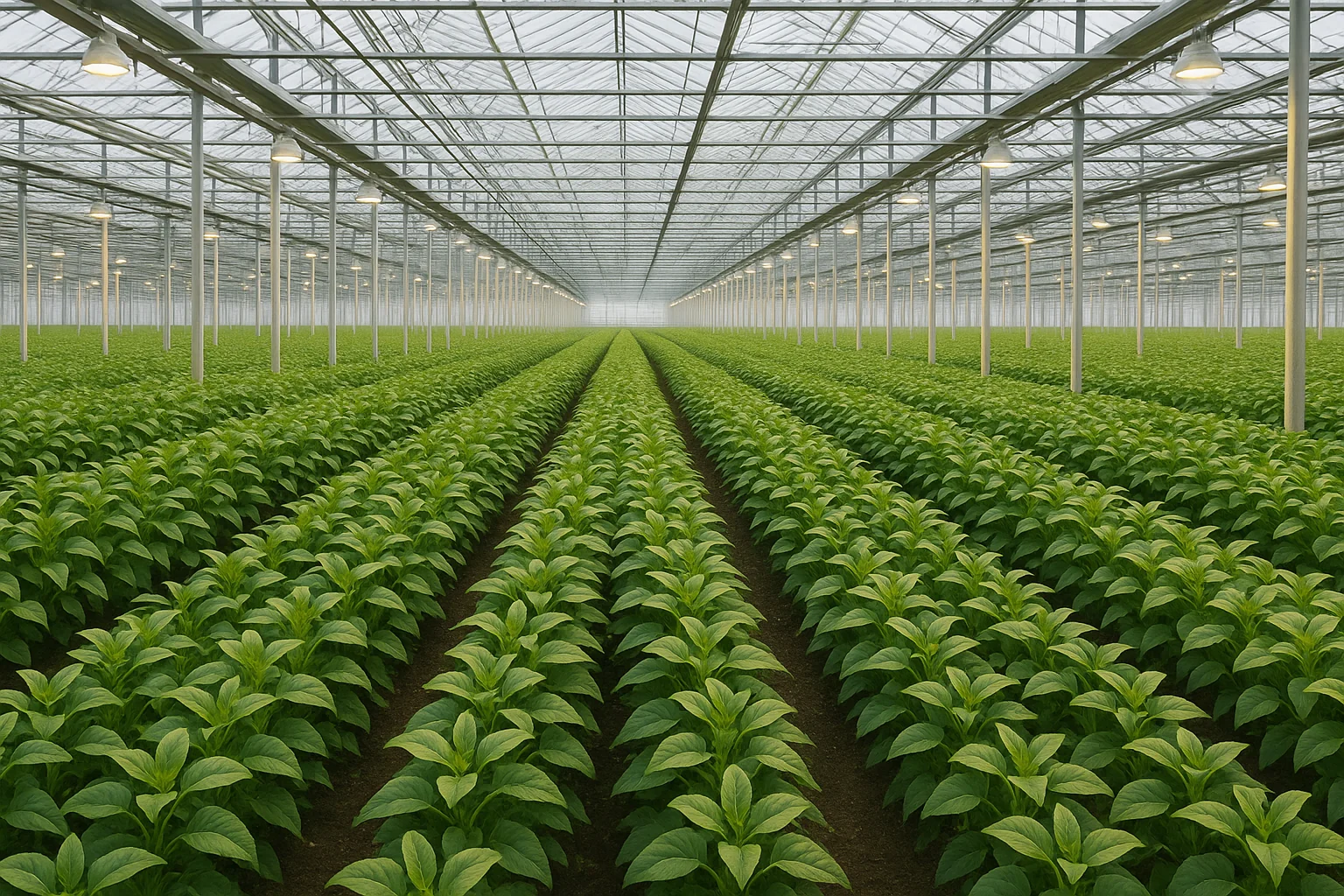
1. 🌍 Large-Scale Plant Production
If you need to produce a large number of plants quickly, micropropagation is your go-to method. It’s perfect for commercial growers or anyone wanting to multiply plants efficiently. 🌿
2. 🚫🦠 Disease-Free Plants
Micropropagation ensures that every plant grown is free from diseases and pests. If you’re dealing with plants that are particularly susceptible to diseases or pests, this method guarantees healthy, strong plants. 🌱
3. 🌸 Rare or Hard-to-Root Plants
Some plants are difficult to propagate using traditional methods. Micropropagation is ideal for growing rare or challenging species that won’t root or reproduce well through cuttings or seeds. 🌻
4. 🔄 Consistency in Plant Traits
When you need genetically identical plants that all share the same size, shape, and characteristics, micropropagation is the best choice. This is especially important for commercial growers or anyone looking to maintain uniformity. 🌱
5. ⏳ Quick Turnaround Time
If you’re in a hurry to see results, micropropagation offers rapid plant growth, making it perfect for getting plants to market or for personal projects that require fast reproduction. 🕒
Choosing micropropagation is best when you need speed, consistency, and high-quality plants for large-scale or specialized needs. 🌿
🌿 When to Choose Traditional Propagation 🌸
Traditional propagation is the perfect option for gardeners who prefer a simpler, more hands-on approach. Here are some situations where traditional methods shine: 🌻
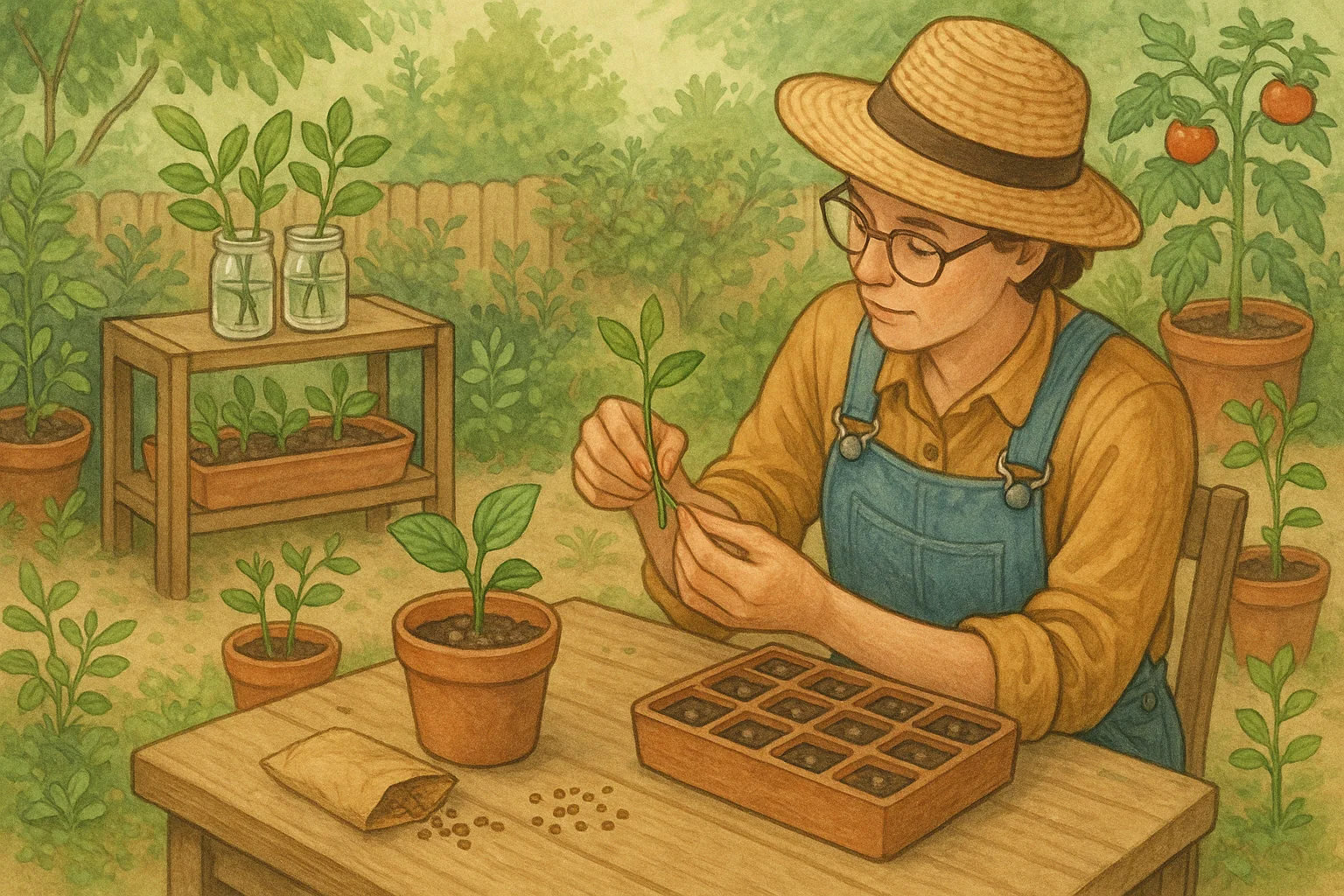
1. 🏡 Home Gardening or Small-Scale Projects
If you’re a hobbyist or growing plants in small quantities, traditional propagation is cost-effective and easy to manage. You don’t need expensive equipment, making it ideal for personal gardens or small-scale setups. 🌱
2. 💰 Low-Cost Planting
When working with a tight budget, traditional methods are the most affordable way to propagate plants. No special tools or environments are required, just basic supplies like soil, pots, or rooting hormones. 🌿
3. 🌻 Simple, Hardy Plants
For plants that are easy to propagate, like succulents, herbs, or common houseplants, traditional methods (like cuttings or division) are often sufficient and give great results. 🌸
4. 🌳 Natural Variation in Plants
If you want plants with a bit of variety in shape, size, or flowering, traditional propagation methods allow for natural genetic differences. This can add character and diversity to your garden. 🌱
5. 🌸 Enjoying the Process
If you enjoy the hands-on process of planting, rooting, and watching plants grow at their own pace, traditional propagation offers a more rewarding, personal experience. 🌿
Traditional propagation is perfect for gardeners who prefer simplicity, affordability, and a more natural approach to growing plants. 🌻
⚖️ Challenges of Both Methods 🌱
While micropropagation vs. traditional propagation both have distinct advantages, each method also comes with its own set of challenges. Here’s a breakdown to help you understand the potential obstacles you might face: 🌿
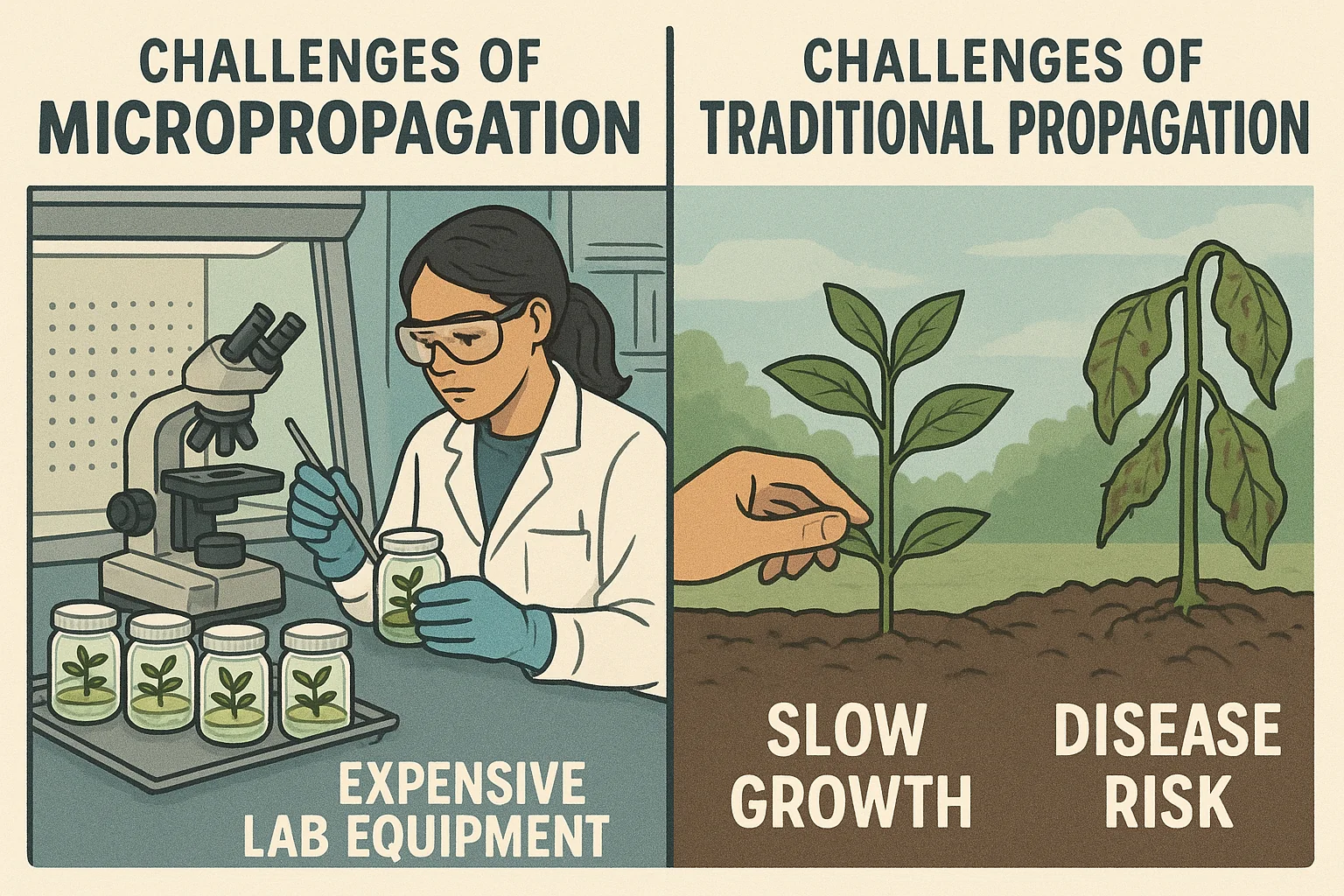
💡 Challenges of Micropropagation
- Expensive Equipment 💰
Micropropagation requires specialized tools and a sterile environment, like laminar flow hoods and controlled growth chambers, which can be costly to set up and maintain. - Technical Expertise 🧑🔬
This method requires a certain level of knowledge and experience. Without the right skills, it’s easy to make mistakes that can ruin the whole process. - Time-Consuming Setup ⏳
While the plants grow quickly, setting up the sterile environment and preparing the culture media can take significant time and effort. - Limited to Specific Plants 🌱
Not all plants are suited for micropropagation. Some species may not thrive in tissue culture or may require extra care to develop.
🌿 Challenges of Traditional Propagation
- Slower Growth 🐢
Traditional methods generally take more time for plants to root and grow compared to micropropagation, meaning you’ll have to wait longer to see results. - Risk of Disease 🦠
When working with cuttings or seeds, there’s always a risk of introducing diseases or pests, especially if your environment isn’t sterile. - Inconsistent Results 🌱
Plants grown through traditional methods can show more variation in size, shape, or overall health. If you need consistency, this could be a drawback. - Limited Scalability 📉
Traditional propagation works well for small-scale projects but may be inefficient for large-scale production due to the time and space required for each plant.
Understanding these challenges will help you decide which method best fits your needs and how to prepare for potential setbacks in your propagation journey. 🌿
🌿 Which Method is Right for You? 🌱
Choosing between micropropagation vs. traditional propagation depends on your goals, resources, and the type of plants you’re working with. Here are some practical tips to help you decide:
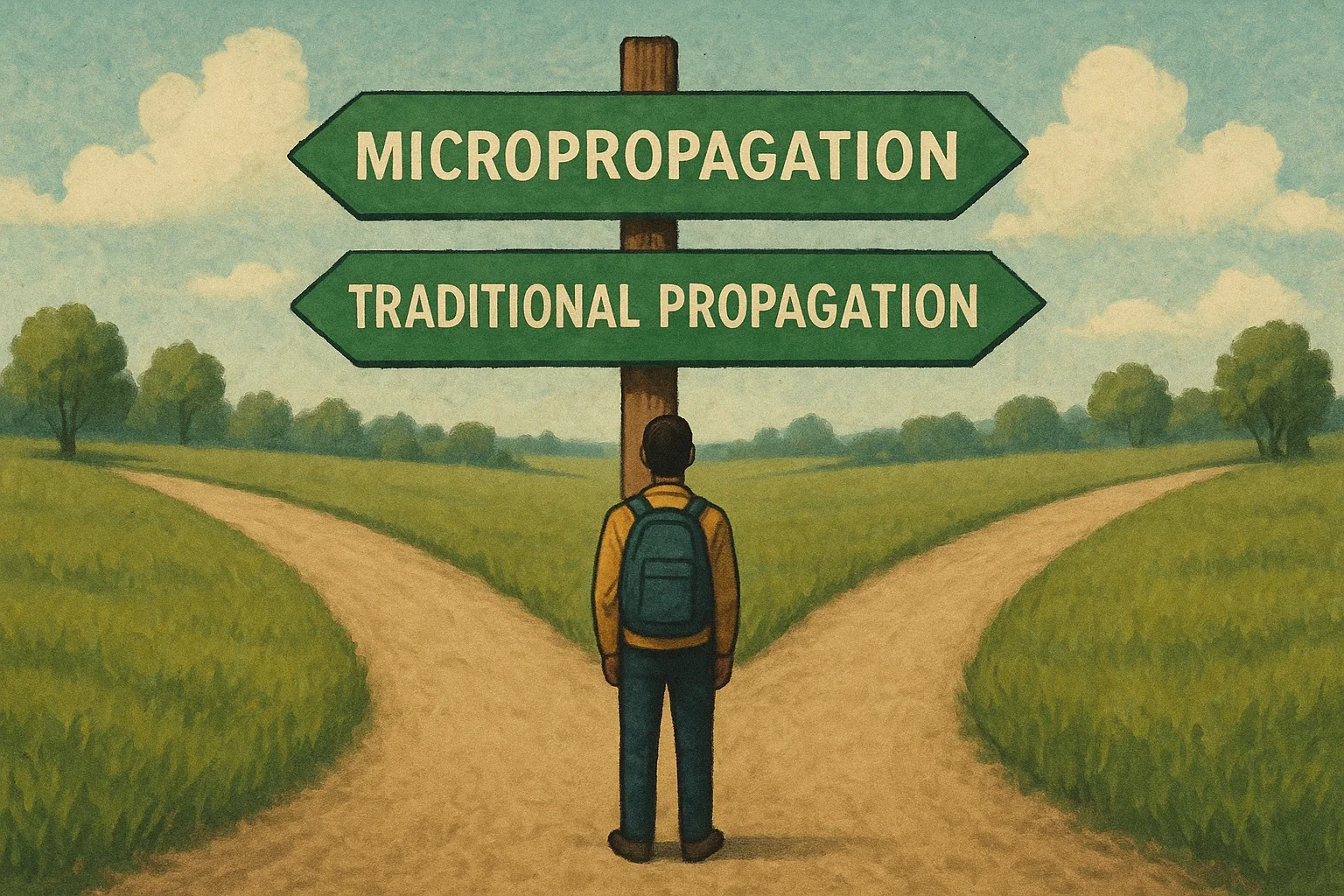
Choose Micropropagation If:
- You need to scale up quickly: If you’re looking to produce a large number of plants in a short time, micropropagation is your best bet. 📈
- You want genetically identical plants: This is ideal for maintaining uniformity in plant traits, especially for commercial purposes or rare species. 🔄
- You’re dealing with disease-prone plants: If you need to ensure disease-free plants, micropropagation offers a sterile, controlled environment to minimize the risk of pests and diseases. 🚫🦠
- You have the budget and equipment: If you can invest in specialized equipment and the necessary knowledge, micropropagation can give you faster, higher-quality results. 💰
Choose Traditional Propagation If:
- You prefer a simpler approach: For beginner gardeners or those who enjoy a hands-on process, traditional propagation is straightforward and easy to manage. 🌸
- You’re working with common, hardy plants: If you’re propagating plants that are easy to root or grow from seeds (like succulents or herbs), traditional methods are sufficient and cost-effective. 🌱
- You have limited resources: No need for expensive equipment—just basic supplies and your green thumb! 🌿
- You want variety: If you enjoy seeing some variation in your plants or want to experiment with different growth traits, traditional propagation allows for natural differences. 🌳
🌱 A Hybrid Approach 🌿
In some cases, combining both methods can be effective. You might start with micropropagation for fast, disease-free multiplication and switch to traditional methods for varieties that thrive better with soil-based techniques.

The method that’s right for you depends on your resources, goals, and the specific plants you want to propagate. 🌿✨
🌿 Final Thought 🌸
In the debate of micropropagation vs. traditional propagation, both methods have their unique strengths and challenges. Micropropagation offers speed, consistency, and disease-free plants, making it ideal for large-scale production and rare plant varieties. However, it requires specialized equipment and expertise. On the other hand, traditional propagation is simple, cost-effective, and perfect for small-scale gardeners or those looking to enjoy the natural variation in their plants.
Ultimately, the right method depends on your needs, resources, and the types of plants you’re working with. Whether you’re a hobbyist experimenting with cuttings or a professional looking to multiply plants rapidly, both methods have something valuable to offer. 🌿
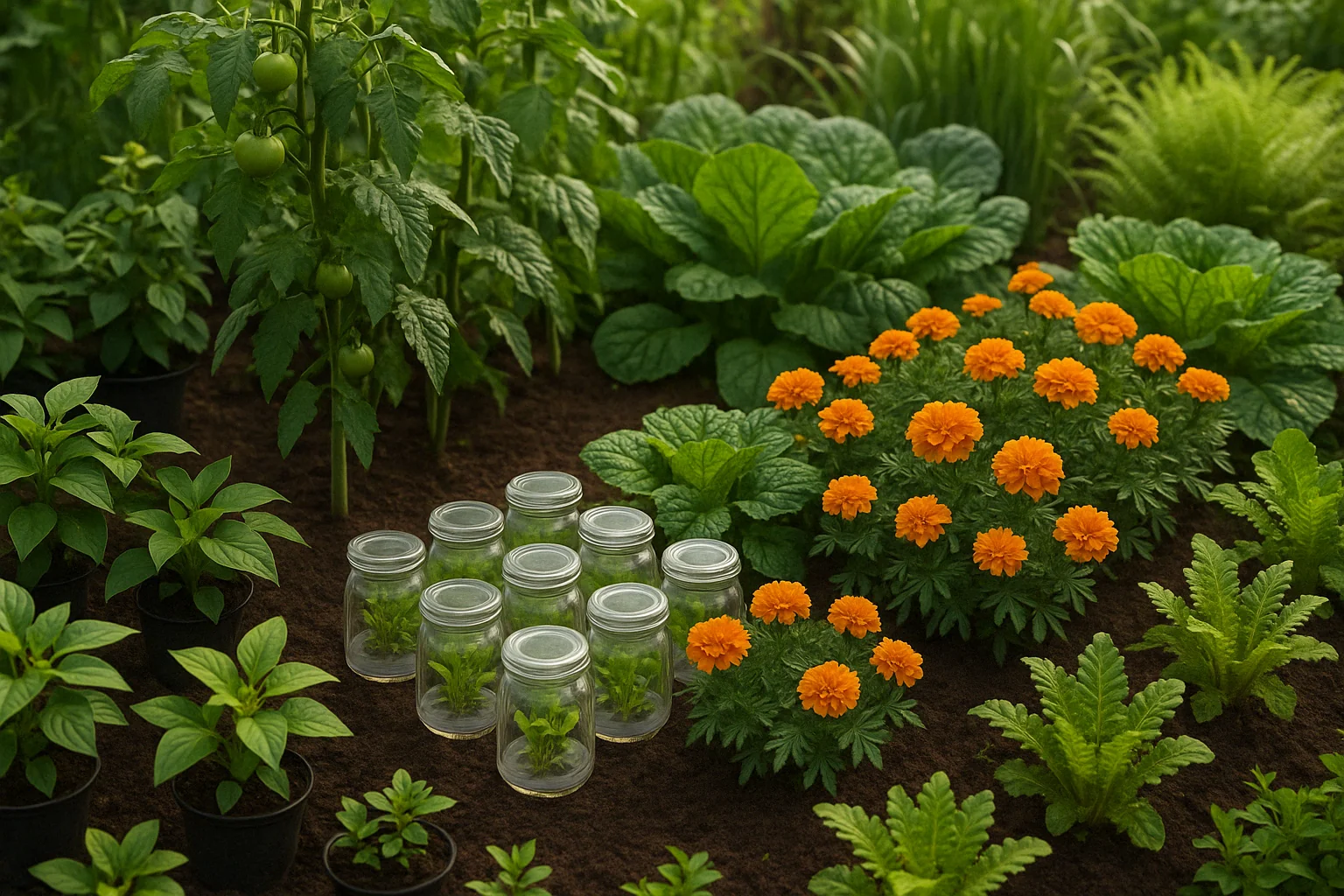
Remember, whichever method you choose, patience, care, and understanding your plants are the key to success! 🌱🌸
Frequently Asked Questions (FAQ)
What’s the main difference between micropropagation and traditional propagation?
Micropropagation uses tissue culture in a sterile environment to rapidly grow genetically identical plants, while traditional propagation involves methods like cuttings, seeds, or grafting, which take longer and may produce more variation in plants.
Can I use micropropagation for all types of plants?
No, micropropagation works best for certain plants, especially those that are difficult to propagate using traditional methods or those that need to be disease-free. Some plants may not thrive in tissue culture.
Is micropropagation more expensive than traditional propagation?
Yes, micropropagation typically requires specialized equipment, a sterile environment, and technical expertise, making it more costly than traditional propagation methods, which are simpler and less resource-intensive.
How long does it take for plants to grow using micropropagation?
Micropropagation offers a faster growth cycle. Once the tissue culture is established, it can result in mature plants in a matter of weeks to months, depending on the species.
What are the risks of traditional propagation?
Traditional propagation methods can result in slower growth, a higher risk of diseases, and potential variations in plant traits. Additionally, not all plants are easy to propagate this way.
Can I use both micropropagation and traditional propagation together?
Yes! Combining both methods can be effective, especially if you use micropropagation for rapid multiplication and then switch to traditional propagation for varieties that are easier to grow naturally.
Is micropropagation suitable for home gardeners?
While micropropagation is more commonly used in commercial settings, experienced home gardeners with the right tools and space can experiment with it. However, it’s more complex and requires sterile environments and precise care.
Which method is best for propagating rare or endangered plants?
Micropropagation is often the best method for rare or endangered plants, as it can produce large numbers of genetically identical, disease-free plants quickly and efficiently.
